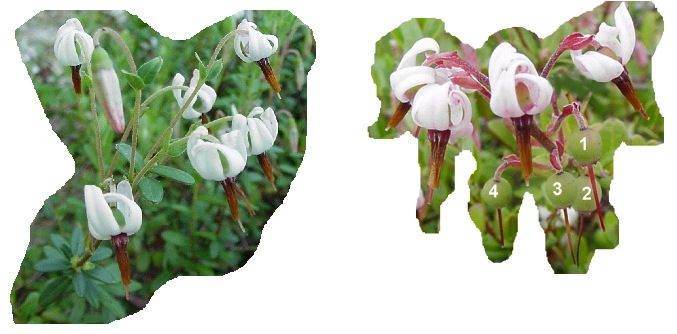Calculating Out-of-Bloom Percentage
Calculating Percent Out-of-Bloom in Cranberry (scroll down for a practice exercise):
Percent out-of-bloom is monitored in cranberries to assist in the management of the cranberry fruitworm (i.e., spray timing). It is good to visit 5 to 10 different random spots throughout a bed, counting the blossoms and/or pinheads and berries on 5 or more consecutive uprights at each location. The location and starting upright should be random (don’t pick the best spot, in other words). A good technique is to stop after every 20 steps, or any number you predetermine, and then begin counting with the upright closest to your last step. The more uprights and locations in the bed you check, the more confident you can be with the result.
Formula:
% Out Of Bloom = (Total number of pinheads and berries ÷ Total number of pinheads + berries + flowers + unopened flowers) X 100%
- When 50% out-of-bloom is reached, the conventional practice ‘used to be’ to apply a pesticide application 3-5 days later for Stevens, 5-7 days later for Ben Lears, and 7-9 days later for Early Black and Howes. The UMass recommendations have shifted now, however: Current thinking is that for early varieties, especially Stevens, the first spray should be timed for the same time as the 50% out-of-bloom date. However, this is challenging since honey bees and other native bees are still foraging at that time, so pollinator-friendly materials should be given heavy consideration as being a better choice under those circumstances. [Intrepid®, for example, can be applied right at the 50% out-of-bloom stage, for all varieties. Altacor® is another compound that can be applied from zero to 7 days after 50% out-of-bloom for all varieties except for Howes, which is a little later at 7 to 10 days following 50% out-of-bloom.]
- Proper management should limit losses to less than 3 percent of the fruit.
- In the event of unusually warm or cool weather during fruit set it may be advisable to shorten or lengthen accordingly the interval before, or between (depending on cultivar) the 50% out-of-bloom date and the first spray.
Additional Treatments? If you are unable to monitor eggs, use the following guidelines:
- 2nd application 10-11 days after the first application;
- 3rd application may be needed during years of VERY high fruitworm populations, 10-11 days after the 2nd application; Two sprays seem to be plenty adequate for growers in Maine, however, and sometimes only one is needed.
Preferably, monitor for eggs to decide if more than just a single treatment is needed (this is difficult, however, without significant magnification; ideally, one needs to be using a dissecting scope): Five days after the first treatment, inspect randomly-picked berries (with a minimum of 200 berries per single, large piece) for eggs. Follow the guidelines in the table below to determine if a spray is warranted. If egg numbers trigger a spray, spray as soon as possible. Otherwise, repeat the berry inspection process every 3-4 days until the egg-laying time has passed (around Aug. 20th). If fruitworm pressure is low through fruit set, it may be safe to extend intervals between berry sampling dates.
TABLE RECOMMENDED (for all practices) TO DETERMINE NECESSITY OF ADDITIONAL SPRAYING FOR CRANBERRY FRUITWORM:
| Number of Acres | Number of Berries Checked | Number of Viable Eggs Needed to Trigger Spray during profitable berry prices |
Number of Viable Eggs Needed to Trigger Spray during very low berry prices (< $0.30 per lb.) |
|---|---|---|---|
| 0-5 | 200-250 | 1 | 2 |
| 6 or 7 | 251-350 | 2 | 4 |
| 8 or 9 | 351-450 | 3 | 6 |
| 10 or 11 | 451-550 | 4 | 8 |
| for each additional 2 acres | add 100 berries | add 1 egg | double the number determined at left |
Practice Exercise: [show me the answer]
What is the % out-of-bloom after checking the two uprights pictured below? The pinheads are numbered 1-4 just so you can see them better in the photo. [Don’t forget to count any unopened flowers, too!]

